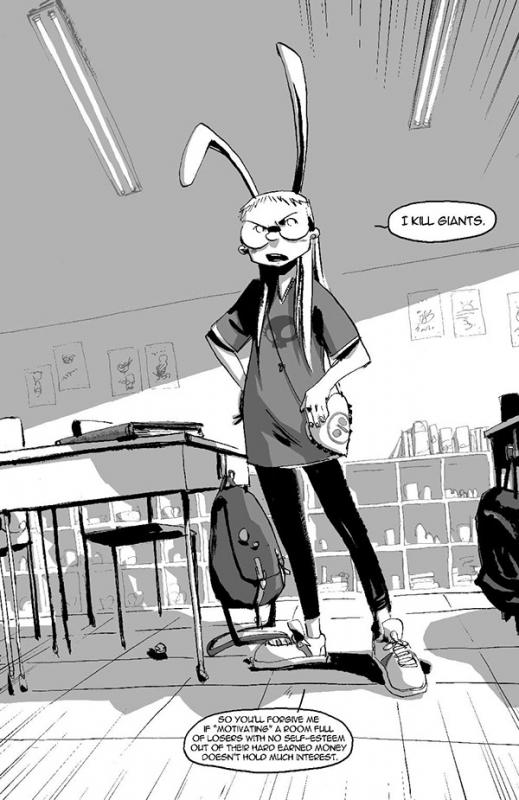While ago I saw on Netflix the film ‘I Kill Giants’ directed by Anders Walter and starring Madison Wolfe - which I enjoyed. Few days later I found in my library the comic book by writer Joe Kelly and artist Ken Nimura from which the film had been adapted. I read and enjoyed that. It got me to musing on how we read comics. In the ‘I kill Giants ‘ comic there is an interesting thing going on with the hero Barbara’s appearance. For a good amount of the time she has what appear to be tall skinny rabbit ears sprouting from the top of her head. Then she doesn’t. In other episodes Barbara has teddy bears ears and in one sequence, horns. The rabbit ears reappear then go again. In the film Barbara does appear for a while with rabbit ears, albeit somewhat shorter, and which are attached to a headband she wears. It was thought to necessary to address and explain the ears. Barbara is pointedly asked ‘why the ears?’ and replies with something about acknowledging the animal spirits. The comic offers no explanation of why the ears. It offers no explanation of why the changes in form or of why they come and go. They were an addition to Barbara’s appearance by artist Ken Nimura who says of them “I absolutely wanted Barbara to have a unique look, . . . something that with a single glance could tell us Barbara is a complete alien compared to other characters.” So they are a visual indication of her as different. But we don’t have to take Nimura’s word for it. They could also signify her sense of herself as ‘other’ or the perception of her otherness by people around her. Their changing could additionally be a sign of her mood. In this comic all this is quite un-troubling. We are content to bring our own thoughts and responses. It is understood that this is an imagined world with it’s own internal logic, at least in a formalised or even fairy story way. (This is not to give Carte blanch to script writers. Some insults to reason and consistency can be hard to ignore or forgive. For example, in comics, Batman’s tussles with giant everyday objects, in film, Superman turning the planet backwards to reverse time - as opposed that is to killing every living thing on earth.) In ’I kill Giants’ Barbara is living with a fantasy that the reader accepts as being at least as real as it is for Barbara since the narrative often takes us inside her head where a good deal of the story takes place. The film asks ‘why the ears?’ and replys with ‘animal spirits’. So that’s the answer to that question. Save that we hadn’t asked and didn’t need to. Reading this or any other comic calls for active mental and imaginative input from the reader. There are gaps in the narrative, if only between frames, that call on the imagination, intelligence and experience of the person who reads to complete. A comic is a cooperative creative enterprise between the authors and the audience. This, from an article in the Feb.27th Guardian ‘Your brain is not a computer”, seemed relevant. ( the brain) “is an active organ, part of a body that is intervening in the world, and which has an evolutionary past that has shaped its structure and function. According to “ (the Hungarian neuroscientist György Buzsáki in his recent book The Brain from Inside Out ) “the brain is not simply passively absorbing stimuli and representing them through a neural code, but rather is actively searching through alternative possibilities to test various options. His conclusion – following scientists going back to the 19th century – is that the brain does not represent information: it constructs it.” For those interested in neuroscience the full article is at - https://www.theguardian.com/science/2020/feb/27/why-your-brain-is-not-a… .



